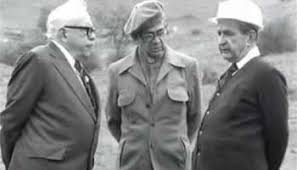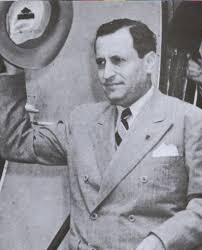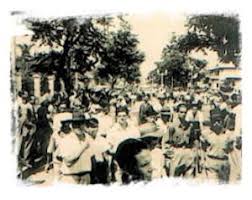Historiographic evolution and civil war
Interpretations of historical events can create concerns in the academic world; this is due to the healthy practice of reflection, especially when a balance of the possible empirical reaches of historical events is placed on the table from different explanatory points of view. In reality, war events tend to be one of the most controversial elements in modern societies, and the last civil war in Costa Rica is no exception.
Since the end of the armed conflict in 1948, there has been a wide historiography that, starting at the beginning, was in a constant opposition of partisan ideas about the origin of said war, however, in the last decade there seem to be not so many discrepancies, replacing it with a kind of academic agreement, according to the possible explanations surrounding the events that occurred during this historical episode, by those knowledgeable in the matter.

Indeed, the most recent interpretations of the antecedents of the civil war have been made from a shared perspective among experts, with a lot of dialogue but little discussion to refute alternative ideas, contrary to what happened in the past when the problem was more politicized in the posthumous heat of the confrontation.
The above is due to the fact that the most recent productions are condensed works in the same explanatory line,without any choice between them.
We could say that prominent historians such as Iván Molina, Mercedes Muñoz Guillen, David Díaz and Manuel SolísAvendaño visualize that social reform is part of a political strategy to confront the advance of communism in the country by becoming the PartidoComunistain the second force of the electoral roll. In turn, this vision of the anti-communist struggle, with its respective alliances and tensions, extends in one way or another to explain the way in which the 1940s ended up exploding into civil conflict.
However, in statistical terms, this left-wing political group was never a real threat, since the electoral capacity of the PartidoRepublicano Nacional in the presidential election of 1940 was indisputable when Calderón Guardia was elected with almost 85% of the votes; something similar happened in the cases of deputies and municipalities in the central areas of Limón and San José. The foregoing shows that the communists were in a certain way popular at the national level but were never even close to contesting the presidency or any other regional political office in a threatening way to the ruling party.

In other words, this explanatory line in which the Partido Republicano Nacional, with Calderón Guardia at the head, sought to confront the communists, could not, by itself, account for such a drastic process in the decision-making of the leader by seek the support of the Partido Comunista, with all the political implications that this entailed, beyond understanding that the anti-Nazi context of the Second World War offered certain plausible conditions for the emergence of unusual alliances between the church, the Communists and the Republicans for a particular period of time (1943-1948).
However, this hypothesis or vision which proposes the existence of a political strategy of a caudillismo nature on the part of the government to confront the communists electorally is still awaiting a satisfactory argument and verification, since the PartidoRepublicano Nacional from 1932 to 1948 was an indisputable electoral force.
Reform and social conflict
In a conference held during 2015 at the Rodrigo Facio headquarters of the University of Costa Rica, regarding state formation in Costa Rica and Nicaragua, historian Víctor Hugo Acuña proposed from a comparative perspective that the formation of the Costa Rican state, consolidated in turn in the last civil war, it is not the result of agreements between the elites, but rather the manifestation of a process that corresponds to a political-military outcome, the foundation of which is based on class conflict, since conflicts ethnic groups are of less importance in the country.
Now, this phenomenon in favor of the development of the State did not seek to agree on the future of the country, rather, it had the purpose of extending the consolidation of benefits provided by the state apparatus, without dismantling the status achieved by previous leaders, in contrast to the Nicaraguan case that faced a series of irreconcilable ideological struggles and military invasions from abroad. Well, in Costa Rica, from the first thirty years of independent life, a legitimated and consolidated state figure had been established from San José as a representation of centralized power, without neglecting the characteristics of the Costa Rican context that made up these elites for ex share part of the state’s success.
Indeed, it is necessary to take as a basis the thesis raised by Acuña, in which it is possible to propose an alternative interpretation to expose a vision of the armed conflict of 1948, seen as an outcome from a class struggle, it is understood through the study of two social spheres in conflict: the subaltern classes facing the social struggle and motivated by what the social reform represented for each; while, on the other hand, the elites clashed politically in the quest to lead new economic development projects in Costa Rica, guided by the need to access power through control of the means of coercion.
Similarly, in 2019, two other related talks were held at the University of Costa Rica, by the Carthaginian historian, Francisco Javier Rojas, on the subject of the July 1918 and 1920 strikes in favor of the Eight-hour day in Costa Rica from a new interpretation of the social reform of 1943. Thus, this approach to the problem radically disagrees with the interpretations of Molina, Avendaño and Díaz on the origins of the social reform, starting from the studies of the struggles social. The historian also makes it clear that, when reviewing what was published by his colleagues, a vision of social reform was found, which in the first instance was specified around the 1940s; and second, it seems that sometimes the authors offer the idea that social reform was a policy directed from above and not coming from the subordinate sectors.

However, Rojas explains that no author mentioned so far has rescued the memory of the true participants of the social reform, that is, unions, workers and mutual organizations, since they have focused on the comparative analysis of the version of events by part of politicians, religious leaders and diplomats, therefore, these works lack a development with respect to the possible social struggles that led to the enactment of social reform. In addition, he expresses that both Molina and Díaz visualize social reform as a political strategy to confront the popularity of the communists. However, as already noted, the PartidoRepulicano Nacional had massive, overwhelming and triumphant support, which left them without any possible electoral competition.
It could be added that Iván Molina himself, in an exemplary way, has reconstructed the Partido Republicano Nacional statistics useful to explain how fraud was not decisive for the triumph of Calderón Guardia, not even for the presidential elections of 1948, affirming in his writings that he is aware of the limitations adjacent to the research being produced thus far.
On the other hand, Rojas exposes a very interesting explanatory principle from which the sociologist Manuel Solís Avendaño starts, in which the social reform was derived from an authoritarian streak that responded to a containment of the social conflict, although well, the historian adds an element more to this thesis, being, rather, the confrontation with social conflict the cause of political change. It can be added to this idea that Solís Avendaño points out that the two sides of the working class fought discursively for noble and just causes, some for social reform and others for the purity of suffrage, being a phenomenon that would help to calm the discomforts of civil war with the passage of time.
This is based on the idea that Calderón Guardia and the Republican are forced to pass legislation because social confrontation was overflowing. For that reason, Rojas ends by stating that the law of the eight-hour day was achieved by the strikes of 1920 during the highest peak of social unrest but it was systematically violated, causing workers such as carpenters and cabinetmakers between 1920 and 1943 to fight in favor of compliance with said legislation; also this process applies to the right to organize, minimum wage and right strike, so, most rights that appeared in the Labor Code (Código de Trabajo) of 1943 are the result of a constant social struggle and a mobile institutionalizing towards uncontrollability of the social question.
In fact, Rojas reveals that there were other unsuccessful attempts to institutionalize the social conflict, such as the creation of the Technical Labor Office (OficinaTécnica del Trabajo) in 1932. In addition to an unfavorable context in terms of the demands won by the workers. Finally, the speaker warns that the increase in social conflict is related to the difficult economic conditions faced by the subaltern classes between 1942 and 1943 since the wage increases did not compensate for the high growth in the cost of living; Without forgetting that, of the eighty-eight workers’ organizations between 1940 and 1943, twenty of these were fighting for social guarantees, not to support Calderón Guardia, but in favor of social legislation.
Project and economic struggle
It is possible that, in turn, the civil war represented a conflict of elites vying to dominate economic development projects for the country. The philosopher and sociologist Jorge Rovira Mas has pointed out that after 1948 two different nuclei of business interests were configured since the first was anchored in the old dynamics of accumulation of capital of an agro-export nature; and the second had been dazzling through the diversification of the productive structure, in the search for a new capitalist development model, which would allow greater independence to the external crises of the world economic system, sustaining its hopes in the industry manufacturing and inward development.
The crash of 1929, as well as the First World War, had revealed how weak and dependent the Costa Rican agro-exporting economic model was on reacting to external crises and the collapse of European and American markets. The convulsive decade of the 1940s, in addition to the political-social framework that characterized it during World War II, added to it the limitations of an agrarian economic model that had once been partially successful only for the oligarchic elite and not so successful for the rest of the country’s population. Therefore, the temporal division indicated by the traditional Costa Rican historiography, in which the civil war is proposed as the watershed that ended the liberal State, is a reinforcement of the argument accepted by most historians regarding the idea of that new business forces took control and transformed the country’s political economy after this confrontation.
For its part, this second group pointed out by Rovira had been pressing to influence the country’s economic policy more and more in order to establish the necessary mechanisms or the necessary structure to allow a diversification of the economic apparatus, therefore, the creation of the Servicio Nacional de Electricidad in 1928 andthe Ley de IndustriasNuevas in late 1940 are examples of this task. While it is true, it should not be overlooked that much of the investment in the incipient industrial sector came from a visionary sector of the coffee oligarchy (in a desire to diversify their investments), also the role of new immigrants in the economy and Costa Rican politics would be fundamental to recognize the reconfigurations suffered by the elites and economic groups during this quest to lead the country’s economic policy, just to cite a few examples, the case of the Jamaicans Lindo Bros or the Italian Musmanni family could be rescued .

The historian Silvia Molina in a study after the civil war, in which she explores the establishment of the country’s diplomatic relations with the USSR during the seventies to commercialize coffee, rescues that, beyond the conflict of opinions generated before the commercial approach that the government made with the Soviet Union, the conflict of interest arose between the old coffee oligarchy and the new rich, since the latter would not obtain any kind of benefits with this diplomatic and commercial approach. The foregoing shows the presence of a conflict between the Costa Rican elites, which had been exposed through the armed confrontation but did not necessarily end in 1948. Despite the existence of a pact between the elites, that is, The Ulate- Figueres pact, the dispute to dominate the national economy, either through the import substitution model or what was left of the agro-export core, would continue during the following decades as long as its validity as a means of capital accumulation was allowed them. It is not necessary to clarify that the cauldron-communists were excluded from this economic project as losers in this conflict.
Likewise, the thesis that the country should propose a different economic development model from the one practiced until the first half of the 20th century, since it did not correspond only to an initiative of the new business community, but also had its voice within the national intellectual space, represented by Rodrigo Facio and the Centro de Estudio de Los Problemas Nacionales. Iván Molina has pointed out how this institution would play a significant role during the 1940s, not only laying the foundations for the program to transform the state and economic structure. On the other hand, Rodrigo Facio was secretary of a special commission chosen by the Governing Board and constituted on May 25, 1949, whose purpose was to draft a draft constitution to serve as the basis for the discussions of the Asamblea Nacional Constituyente. Therefore, it is important to note the role of this spokesperson. Like Figueres, Facio led the new political program from different spaces, in this case, as a member and architect of the draft for the draft of a new constitution.
For his part, José María Figueres Ferrer was the son of a Catalan doctor who arrived in Costa Rica at the beginning of the 20th century and settled in the city of San Ramón, and as an adult, he would become the political figure who represented two emerging groups within the Costa Rican elite, that is: the immigrant political-economic actor and the leader of intellectual theorists through a new policy of economic diversification for the country, and it will also be he who will crystallize the forces of political change after taking power thanks to the use of war, recognizing the armed route as the only option to be taken into account in political discussions during the national crisis of 1948.
Synthesis of a civil war
There are many causes that could have led to the outcome of the civil war of 1948 in favor of the opposition side, basically with regard to the triumph of the Ejército de Liberación Nacional. The foregoing is very varied, either due to the continuous dismantling of the Costa Rican national army during those years to defend itself against the support of an opposition force of foreign mercenaries, added to the discomfort of some sectors with the wishes of Dr. Calderón Guardia for electoral reelection. and finally, the complaints of national businessmen about the situation in the country and the high social costs.

However, apparently there is something in which there is no doubt, an apparently indisputable fact, which is manifested in that the government was delegitimized in the public eyes and in a continuous crisis. Therefore, the ruling party received criticism from a large part of the young university intellectuals and a massive protest against it, which ended in the much-mentioned Strike of the Fallen Arms of 1947. Said movement was supported by rural and urban workers who protested against the precarious situation in which, supposedly, the government had allowed the country’s petty bourgeoisie to fall, turning this event into the pillar of new violent spaces of social confrontation against communism, being seen as the political enemy, evidently, the opponents were protected by the new ideological project of the Social Democracy. Said general strike led to the creation of a Tribunal Nacional Electoral that, left in the hands of the opposition, played a decisive role in discrediting Calderón’s triumph in the 1948 national elections and became a legitimizing body of the discourse in defense of suffrage. Apart from this, it should be noted that the representatives of the United States were afraid because of the alliances still present with the Creole communists, causing them to stay away from intervening in a direct way.
It should be said that we have not referred to a class conflict, as the political scientist Fabrice Lehoucq studies it to criticize this type of approach , especially when they become schematic. Rather, we are analyzing the political- military outcome and the tension of social conflicts that occurred during previous decades.
In summary, throughout this reading, the weakness of the Costa Rican State has become evident, which led it to lose its hegemony in the face of an armed war, where ideological, social, political and economic struggles were faced at the level of The social struggle, represented in violent strikes orchestrated by subordinate groups in favor of social guarantees and opposition to the government, were manifestations of disagreement that gave emphasis to unleash a civil war in 1948. Apparently, as the historian Víctor Hugo Acuña said, this state that we know today is, in effect, the product of the class struggle, not of negotiations between elites.
By: Josué Jiménez Álvarez and José David Ramírez Roldán.

